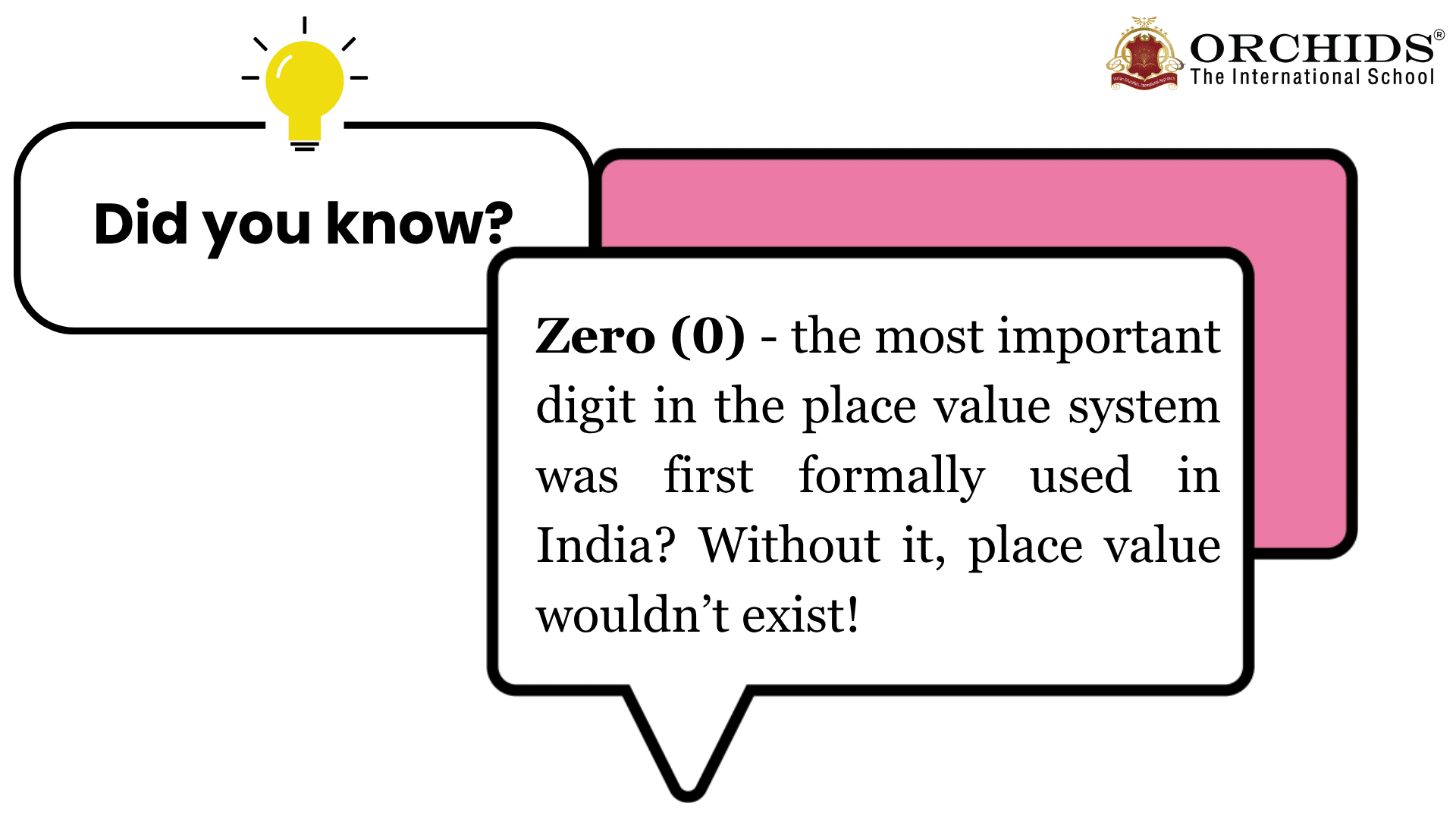Indian Place Value Chart
The Indian Place Value Chart is a chart that shows the periods and places in the Indian System. In the Indian system, digits are grouped into ones, thousands, lakhs and crores, whereas in the International system, the digits are grouped into ones, thousands, millions and billions. Our Indian schools mainly used this chart to teach numbers in the Indian context, which is widely used in currency, population figures, and data interpretation.
This article helps you to understand the Indian place value chart of the Indian numeral system that is culturally and practically relevant across India.
|
Do you know who invented the zero? Be proud to say that the zero was invented by the ancient Indian mathematician Aryabhata. India's contribution towards mathematics is more significant and laid the foundation for today’s decimal system. |
Table of Contents
- What is the Indian Place Value Chart?
- What Is Place Value?
- Indian Place Value Chart Format
- Reading and Writing Large Numbers (with Examples)
- How to Use Commas in Indian Numbers?
- Indian vs International Place Value System
- Solved Examples
- Conclusion
- FAQs on Indian Place Value Chart
What is the Indian Place Value Chart?
The Indian Place Value Chart is a table that tells the place value of a digit in a number. There are nine places and four periods in the Indian place value chart as per the Indian numeral system. To avoid confusion while reading and writing large numbers, we group them into periods with commas. Numbers are used for counting, measuring, comparing, etc.

What Is Place Value?
Place value refers to the value of a digit based on its position in the number. This also helps to write numbers in their expanded form.
For example, in the number 25,674:
-
The 2 is in the ten-thousands place, so it means 20,000.
-
The 5 is in the thousands place, so it means 5,000.
-
The 6 is in the hundreds place, so it means 600.
-
The 7 is in the tens place, so it means 70.
-
The 4 is in the ones place, so it means 4.
Indian Place Value Chart Format
The Indian place value system is a chart or a table used to find the values of each digit in a number as per the Indian numeral system.
Let us understand the Indian place value system using the chart below.

The above chart explains as follows:
-
There are nine places under four periods, such as Ones, Thousands, Lakhs, and Crores.
-
While writing a number in numeral form, it is separated by a comma based on periods.
-
The first period is Ones period that contains three places, i.e., Ones, Tens, and Hundreds.
-
The second period is a thousand period that contains two places, i.e., thousands and Ten-thousands.
-
The third period is the Lakhs period that contains two places, i.e., Lakhs and Ten-lakhs.
-
The fourth period is the Crores period that contains two places, i.e., Crores and Ten-crores.
-
While reading any number, all digits that come under the same period are read together in a group.
Now, write 2674 in the Indian Place value chart.
|
Thousands |
Ones |
|||
|
Ten-Thousands |
Thousands |
Hundreds |
Tens |
Ones |
|
2 |
5 |
6 |
7 |
4 |
Reading and Writing Large Numbers (with Examples)
To read and write the large numbers in words, the Indian place value system breaks into periods such as ones, thousands, lakhs and crores. Commas are separated by periods, which makes it easy to spell.
|
Number |
How to Read It |
|
1,000 |
One thousand |
|
10,000 |
Ten thousand |
|
1,00,000 |
One lakh |
|
5,67,000 |
Five lakh sixty-seven thousand |
|
12,34,567 |
Twelve lakh thirty-four thousand five hundred sixty-seven |
|
1,00,00,000 |
One crore |
|
9,87,65,432 |
Nine crore eighty-seven lakh sixty-five thousand four hundred thirty-two |
Follow the tips to read and write large numbers.
-
Start reading from left to right always.
-
Split the number based on periods.
-
To write commas, start from the right side and each period is separated.
How to Use Commas in Indian Numbers?
There are some processes to be followed while writing large numbers using commas. They are:
-
Always start putting commas from right to left.
-
In the Indian numeral system, the commas are placed after each period, i.e., after ones (3 digits), thousands (2 digits), lakhs (2 digits) and crores (2 digits).
Example:
-
1,000 = One thousand
-
1,00,000 = One lakh
-
1,00,00,000 = One crore
-
12,34,56,789 = Twelve crore thirty-four lakh fifty-six thousand seven hundred eighty-nine
Indian vs International Place Value System
The difference between the Indian place value system and the International place value system has been listed in the table below.
|
Period |
Indian Place Value System |
International Place Value System |
|
Ones |
Ones, Tens, Hundreds |
Ones, Tens, Hundreds |
|
Thousands |
Thousands, Ten Thousands |
Thousands, Ten Thousands, Hundred Thousands |
|
Lakhs/Millions |
Lakhs, Ten Lakhs |
Millions, Ten Millions, Hundred Millions |
|
Crores/Billions |
Crores, Ten Crores |
Billions, Ten Billions, Hundred Billions |
|
Comma Placement |
1,23,45,678 |
123,456,789 |
|
Example |
1,23,45,678 = 1 crore 23 lakh 45 thousand 678 |
123,456,789 = 123 million 456 thousand 789 |
Solved Examples
Example 1: Represent 1924537 using commas in the Indian Place Value System.
Solution:
Use the comma rule 3-2-2 from the right.
73,54,291
Read as: Seventy-three lakh fifty-four thousand two hundred ninety-one
Example 2: Read and write the number 5,67,89,346 in words.
Solution:
Arrange the number in the Indian place value system.
|
Crores |
Lakhs |
Thousands |
Ones |
||||
|
C |
TL |
L |
T TH |
TH |
H |
T |
O |
|
5 |
6 |
7 |
8 |
9 |
3 |
4 |
6 |
Five crore sixty-seven lakh eighty-nine thousand 3 three hundred forty-six

Conclusion
The Indian Place Value Chart builds a foundation for the number system. By learning to place digits correctly in their position, the proper way to use commas and avoid some mistakes, you can improve number sense and develop confidence dealing with large numbers. Whether you're solving problems, managing money, or just reading a population chart, the Indian Place Value System plays a vital role in everyday life.
FAQs on Indian Place Value Chart
Q1: What is the Indian Place Value Chart?
Answer: The Indian Place Value Chart is a chart or a table that shows periods and places of numbers that includes ones, thousands, lakhs and crores periods.
Q2: Mention the periods in the Indian Place Value Chart.
Answer: There are 4 periods and 9 places in the Indian place value chart, as shown in the table below.
|
Crores |
Lakhs |
Thousands |
Ones |
|||||
|
T C |
C |
T L |
L |
T Th |
Th |
H |
T |
O |
Q3: How are commas placed in the Indian system?
Answer: Commas are placed for each period, after ones period, thousands period and lakhs period.
Q4: What is the difference between the Indian and International Place Value Charts?
Answer: The Indian place value system has 3 places in ones period and the remaining 2 places. While the International place value system has 3 places in each period.
Q5: Why is the Indian Place Value System important?
Answer: It helps people in India understand and work with large numbers in daily life, such as in finance, population data, and official documents.
Admissions Open for
Admissions Open for
CBSE Schools In Popular Cities
- CBSE Schools in Bangalore
- CBSE Schools in Mumbai
- CBSE Schools in Pune
- CBSE Schools in Hyderabad
- CBSE Schools in Chennai
- CBSE Schools in Gurgaon
- CBSE Schools in Kolkata
- CBSE Schools in Indore
- CBSE Schools in Sonipat
- CBSE Schools in Delhi
- CBSE Schools in Rohtak
- CBSE Schools in Bhopal
- CBSE Schools in Aurangabad
- CBSE Schools in Jabalpur
- CBSE Schools in Jaipur
- CBSE Schools in Jodhpur
- CBSE Schools in Nagpur
- CBSE Schools in Ahmednagar
- CBSE School In Tumkur











